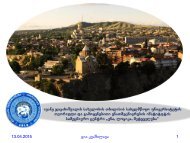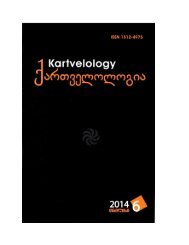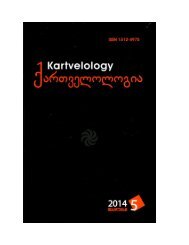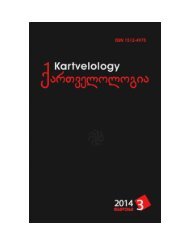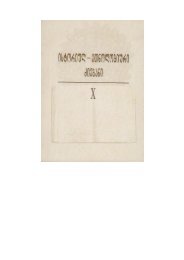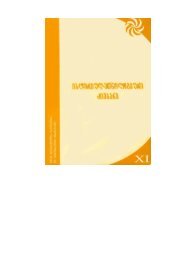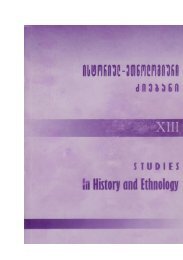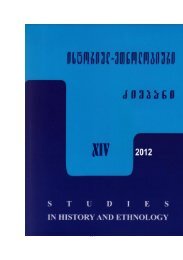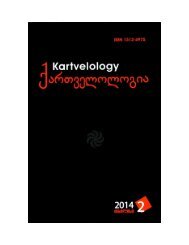Kvashilava, Gia, 2010. On Reading Pictorial Signs of the Phaistos Disk and Related Scripts (2). Rosette (in Georgian and English)
This study concerns the graphic character, symbolic meanings, typological parallels, commentaries and reading of the Phaistos Disk pictorial sign PHD38.
This study concerns the graphic character, symbolic meanings, typological parallels, commentaries and reading of the Phaistos Disk pictorial sign PHD38.
Create successful ePaper yourself
Turn your PDF publications into a flip-book with our unique Google optimized e-Paper software.
After <strong>the</strong> thorough study <strong>and</strong> analysis <strong>of</strong> Assyrian cuneiform<br />
<strong>in</strong>scriptions (Tiglath-Pileser I, 1115/1114-1077/1076 BC) G.<br />
Melikishvili (1954, 22 <strong>and</strong> ff., 407-408; 1970, I, 369, 369 3 , 370)<br />
read Kil i 1 (Kir i: Luckenbill 1926, I, 92, 270) which he<br />
identified with (also see: Lordkipanidze 1986, 45; Gordeziani<br />
2007, III, 469; Gordeziani 2009, 83).<br />
Accord<strong>in</strong>g to Urartian sources (Sarduri II, 750-748 <strong>and</strong> 744-<br />
742 BC), G. Melikishvili (1962, 320 <strong>and</strong> ff.; 1970, I, 386-389,<br />
39-40; 2004, 98, 107-109) identifies <strong>the</strong> Qul a 2 form with<br />
1 . ”It should be noted that many researchers [e.g., C. F. Lehmann-Haupt, I.<br />
M. Diakon<strong>of</strong>f, <strong>and</strong> o<strong>the</strong>rs] read <strong>the</strong> name Kil- i as ab- i. The first sign<br />
( ) is raed not only as Kil <strong>and</strong> ab, but as some o<strong>the</strong>rs syllables, too”<br />
(Melikishvili 1970, I, 369 3 ).<br />
In one <strong>of</strong> <strong>the</strong> <strong>in</strong>scriptions Tiglath-Pileser I says: ”Tukulti-apil-Ešarra,..<br />
who conquered country ab i till ‟<strong>the</strong> Big Sea‟. Accord<strong>in</strong>g to Assyrian<br />
<strong>in</strong>scriptions ‟<strong>the</strong> Big Sea‟ is ‟<strong>the</strong> Upper Sea‟, <strong>and</strong> G. Melikishvili (1970, I,<br />
367-369) argues that this is <strong>the</strong> Black Sea.<br />
I th<strong>in</strong>k that <strong>the</strong> same cuneiform signs <strong>of</strong> <strong>the</strong> <strong>in</strong>scription given above denote<br />
<strong>the</strong> country ab i (comp. ab- i/a, a-ab- i/a-: CAD 1956, 6, 15) that was<br />
not situated to <strong>the</strong> South <strong>of</strong> <strong>the</strong> lake Vani, <strong>and</strong> <strong>in</strong> this case <strong>the</strong> country <strong>of</strong><br />
Chalybes ( : Herodotus I, 28; Suida 1705, III, 652) was meant.<br />
My po<strong>in</strong>t <strong>of</strong> view is supported by Assyrian root ab- i, where - i is a<br />
Hurrian-Urartian suffix (Melikishvili 1970, I, 382, 364); it corresponds to Greek<br />
-. The process: Colchian * - [*xaləb-] > * - [*xaəb-] > * -<br />
[*xab-], where -* - [-*lə-] > -* - [-*ə-] > -ø- is reflexive. This process takes<br />
place <strong>in</strong> <strong>the</strong> local B<strong>and</strong>za-Martvili speech <strong>of</strong> Senaki dialect <strong>in</strong> M<strong>in</strong>grelia. E.g.,<br />
/ / / / [dzalami/dzaljami/dzajami/dzaami/<br />
dzami] – very (Kipshidze 1914, 373; Kajaia 2001, I, 18; 2002, II, 372, 374).<br />
The abovesaid allows <strong>the</strong> acceptance <strong>of</strong> both read<strong>in</strong>gs <strong>the</strong> Assyrian cuneiform<br />
sign as KUR Kil- i <strong>and</strong> KUR ab- i. They both are connected to <strong>the</strong> name <strong>of</strong> <strong>the</strong><br />
country <strong>of</strong> Chalybes – Colchis that lay at ’<strong>the</strong> Big Sea‟ (<strong>the</strong> Black Sea).<br />
2 . Urartian KUR qul- a-i, KUR qu-ul- a-i-di, KUR qu-ul- a- a-li-e- i – Kulkha,<br />
Colchis (155 C, 2; 155 D, 3, 6, 9: Marr, Orbeli 1922, 47-51; Sayce 1929, 95-96;<br />
Melikishvili 1953, #4; Haroutyunyan 2001, 519), where [u] occurs <strong>in</strong>stead <strong>of</strong> [o]<br />
as <strong>the</strong> vowel [o] was not reflected <strong>in</strong> cuneiform script (Tatishvili 2009, 23).<br />
In Urartian <strong>in</strong>scription (155 D, 5) <strong>in</strong> <strong>the</strong> name <strong>of</strong> a k<strong>in</strong>g <strong>of</strong> Colchis <strong>the</strong><br />
first syllable <strong>in</strong> unfortunalely erased I [1]-šá- i only <strong>the</strong> last part -šá- i is still<br />
<strong>the</strong>re (Melikishvili 1953, #4; 1970, I, 388).<br />
321




